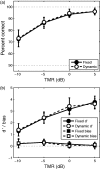A Flexible Question-and-Answer Task for Measuring Speech Understanding
- PMID: 27888257
- PMCID: PMC5131808
- DOI: 10.1177/2331216516678706
A Flexible Question-and-Answer Task for Measuring Speech Understanding
Abstract
This report introduces a new speech task based on simple questions and answers. The task differs from a traditional sentence recall task in that it involves an element of comprehension and can be implemented in an ongoing fashion. It also contains two target items (the question and the answer) that may be associated with different voices and locations to create dynamic listening scenarios. A set of 227 questions was created, covering six broad categories (days of the week, months of the year, numbers, colors, opposites, and sizes). All questions and their one-word answers were spoken by 11 female and 11 male talkers. In this study, listeners were presented with question-answer pairs and asked to indicate whether the answer was true or false. Responses were given as simple button or key presses, which are quick to make and easy to score. Two preliminary experiments are presented that illustrate different ways of implementing the basic task. In the first experiment, question-answer pairs were presented in speech-shaped noise, and performance was compared across subjects, question categories, and time, to examine the different sources of variability. In the second experiment, sequences of question-answer pairs were presented amidst competing conversations in an ongoing, spatially dynamic listening scenario. Overall, the question-and-answer task appears to be feasible and could be implemented flexibly in a number of different ways.
Keywords: dynamic conversations; realistic tests; speech comprehension.
© The Author(s) 2016.
Figures



References
-
- Best V., Keidser G., Freeston K., Buchholz J. M. (2016) A dynamic speech comprehension test for assessing real-world listening ability. Journal of the American Academy of Audiology 27: 515–526. - PubMed
-
- Boersma, P., & Weenink, D. (2016, September 4). Praat: doing phonetics by computer [Computer program]. Version 6.0.20. Retrieved from https://github.com/praat/praat.
-
- Brungart D. S., Simpson B. D. (2007) Cocktail party listening in a dynamic multitalker environment. Perception & Psychophysics 69: 79–91. - PubMed
MeSH terms
Grants and funding
LinkOut - more resources
Full Text Sources
Other Literature Sources

